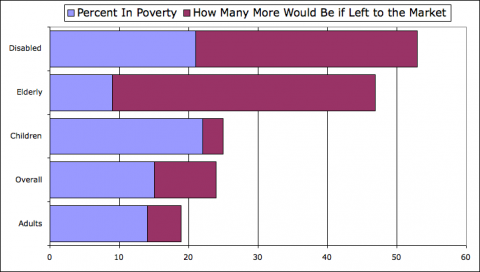How We Reduce Poverty, and How “The Market” Doesn’t
Matt Bruenig gives us a great breakdown of what poverty would look like if we relied on the market to solve it (as we did almost exclusively for thousands of years before the emergence of enlightened modern welfare states over the last two centuries).
The poverty rate among the elderly would be > 45%. (Old folks with long memories: sound familiar?)
Thanks to Social Security, Medicare, etc., it’s 9%.
Here are Matt’s numbers in graphical form for easy digestion:
Read the whole thing.
Cross-posted at Asymptosis.


>>?before the emergence of enlightened modern welfare states over the last two centuries<<<
Hey folks; did we forget about the labor market setup — whether labor can actually bargain by withholding its labor — and that the only effective setup that can survive modern management is LEGALLY MANDATED, CENTRALIZED BARGAINING.
Someday we are going to have a real discussion on the absolute necessity of this decades proven around the world free market setup — with the realization that nothing else can EVER be done unless this is done first. That the private equity looting and the tax dodging expatriating and whatever else progressives complain and moan about will never go away without re-unionization which will put somebody back minding the store(s) — and compliant politicians back in the legislatures awaiting our desires (same financing and lobbying as the 1%/ — plus 99% of the votes!).
[snip]
Look at most of the Americans you meet working on less than specific training required jobs (like x-ray tech): they are embarrassed. They are earning $400-$500 a week. $500 is today's median wage.
Look at the official federal poverty line: 3 X the price of an emergency diet (dried beans only please; no expensive canned) — a formula from the mid-fifties = $20,000 poverty line for family of three ($400 a week). Realistic minimum needs line based on table 3-2, p. 44 (after adjusting for inflation) in the MS Foundation book Raise the Floor works out to more like $50,000 a year for family of three if it has to pay its own medical insurance ($1,000 a week!). HALF OF AMERICANS NOW WORK FOR HALF THAT POVERTY LINE OR LESS!
[snip]
What can a welfare state do about that?
Denis I agree, and look at Germany as a model (a model which is actually illegal in the US). But I also think that as productivity increases, we need to break the moralistic stance insisting that the only acceptable way to live a comfortable life is to work really hard. Insisting that labor unions are the only path to widespread prosperity serves to promulgate that stance.
Our problem is a two party system, both of which neither serve the nation or the majority of the public.
The solution I see is ending one of them. Since it is the one that says vote for us as we are the least worst option. I say end this party that is right of past republicans; which is forcing the republicans ever further right.